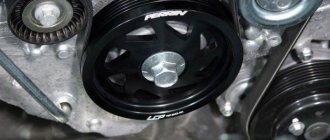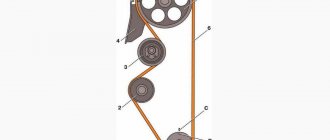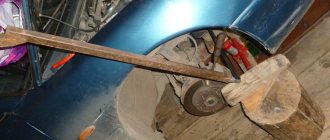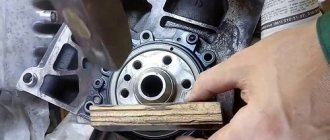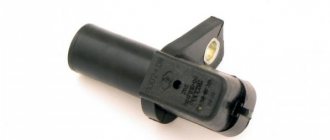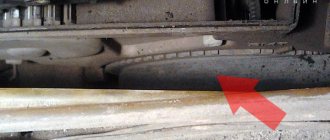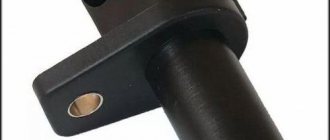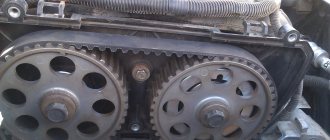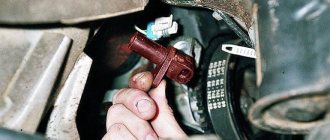Good day to all!
In general, about two months ago I changed the bearings in the gene, but I didn’t put it in the log book because the process was not photographed, and after this time the bearings began to hum again. After driving like this for several days, I said “Stop putting up with this” and drove to a friend’s garage for pit.
We will need:
***bearings 202 and 302 (I personally have these, BATE generator), if you don’t know which ones you have, then first remove them and go to the store) ***generator bearing puller ***brushes (if you haven’t climbed there for a long time, or not changed them, grab them at the same time, I changed mine recently)
I will describe the process of removing and disassembling the generator (I apologize for the quality of the filming, I filmed it on my phone):
1.Remove the negative terminal from the battery 2.Remove the + and - contacts, we will need a key for 10.
3. Loosen the generator position lock with a 13 key and unscrew the long bolt for adjustment, it is 10
4. You can remove the generator in different ways, I personally remove it together with the fasteners because it takes 2 minutes, there are 15 bolts.
5. Next on the table I remove the mount itself from the generator, there is a long bolt at 13. I remove it together with the fastener because it is this bolt that rests on the spar.
6.Next, we remove the pulley from the generator. It seems like a 22mm head is needed, and it is advisable to have a vice. We insert a screwdriver or something else through the generator, thereby blocking the pulley from turning (just be careful, do not bend the blades). Because the first ones once when I was changing the bearings of the generator, we had a vice, we were able to unscrew it without much difficulty, now the vice was already broken and we just inserted screwdrivers: one held the generator from turning, and I unscrewed the pulley nut.
7. Using a Phillips screwdriver, unscrew the screws securing the front and rear covers of the generator, there are four of them (I advise you to spray it with WD40, and in general, spray everything there, spray the entire generator)))) You will also make marks so that you can put them correctly later.
10.After you have removed the front cover, turn it over and place the 22nd head on the bearing, knock it out with a hammer and immediately drive the new bearing through the old one, this can be done without any problems, just be careful.
Crankshaft pulley VAZ 2114
Replacing the generator drive pulley on front-wheel drive VAZ and Lada cars
The generator drive pulley changes in the same way on cars of the “tenth series” (VAZ 2110, 2111 and 2112), the “Samara” series (VAZ 2113, 2114 and 2115), as well as the “new” models of Lada Kalina, Priora and Grant.
The generator drive pulley is located on the “toe” of the engine crankshaft on the side of the first cylinder (right wheel) and drives the generator and, if equipped, air conditioning and power steering using a belt.
The main reasons for replacing a pulley are damage to the ring gear or delamination of the pulley itself.
Damage to the ring gear leads to unstable operation of the motor. If the teeth are broken, the car may not start because the crankshaft sensor (CSS) cannot determine the top dead center (TDC) for the ignition count.
Delamination occurs on damper pulleys (not cast iron). The fact is that on these pulleys the outer part is attached to the central part through a rubber spacer. It acts as a vibration damper (anti-resonance) on the engine crankshaft. It happens that the outer race rotates a little. Then the toothed pulley moves relative to the dead center and, as a result, the car becomes “sluggish” during acceleration, and the idle speed becomes unstable. If the pulley is too misaligned, the car cannot be started. Also, the car will not start with the upper race completely peeled off from the central part of the pulley.
Such damage is easily diagnosed by the lack of rotation of the alternator belt.
In rare cases, the seat key on the shaft breaks, and the pulley begins to vibrate and rotate. If the movements are small, then the ECU does not display an error on the instrument panel, but at the same time the engine at idle is unstable and “troits.”
Checking the condition of the pulley is quite easy. To do this, you need to inspect the condition of the ring gear for chips and cracks. The ring gear is located on the outer race closer to the engine (indicated by an arrow) and is clearly visible from above:
After this, you need to set the first cylinder to TDC. To do this, in an 8-valve engine, remove the rubber plug on the gearbox and ensure that the mark on the flywheel aligns with the slot on the plate:
You can check by the mark on the camshaft. To get to the mark, you need to unscrew the plastic protective cover. Fasten with three “10” bolts (two are shown in the photo, the bottom one under the hose from the end of the casing):
After unscrewing the casing, pull it up. There is a mark on the camshaft pulley (right arrow). We combine it with the protrusion of the metal plate (left arrow).
Pulley removal
Unscrewing a fastening bolt or nut is only half the battle. Next you need to pull the pulley out of the shaft. The pulley cannot be removed easily by hand unless its seat is broken. In addition, if the pulley fits tightly onto the shaft, it is also secured against turning by a key.
There are special pullers for removing the pulley from the shaft. There are mechanical and hydraulic pullers.
The design of a mechanical puller is simple. Usually it has three legs, with which you need to hook the pulley itself, and rest the central rod against the shaft. After which, you need to rotate the rod, the legs will straighten and pull the pulley towards you.
There are even simpler pullers that you can make yourself.
If there is no removable device for the pulley, then you can use pry bars. If one person is filming, then take turns, moving it a little on each side so that there is no distortion. If there are two, then at the same time, from different sides, the pulley is pressed out from the crankshaft with a sharp movement.
It also happens that when using a puller, the walls of the pulley grooves cannot withstand and break off. Therefore, when using pry bars, they must be engaged as close to the shaft as possible.
Signs of malfunction and replacement of the crankshaft position sensor on a VAZ 2114
First, let's look at what a crankshaft position sensor is. The crankshaft position sensor of the VAZ 2114, like many other VAZ models, is an electromagnetic device that transmits information about the position of the crankshaft to the electronic “brains” of engine control. This sensor is very important; the correct operation of the fuel injectors and the ignition system depends on it. It doesn't break down often. But if you are going on a long trip, it is advisable to have a spare one.
Crankshaft position sensor VAZ 2114
Replacing the crankshaft oil seal 4 G93 - stage 2.
Next, one holds it with emphasis against, and the other turns out the pulley (damper) bolt.
11. But, unfortunately, no matter how carefully the owner treats his VAZ 2110, sooner or later the time for physical wear comes for the liners - they need replacement. The only exception is if it is replaced with a new one. At the same time, an experienced craftsman can turn the crankshaft into a lightweight one. When reassembling, please note that the groove on the hub must be aligned with the segment key.
It is impossible to remove the pulley alone, so you should hire an assistant.1. Place the car on a jack and remove the right front wheel (it is also better to place a reliable stand under the threshold, for example, a wooden stump). If the coolant temperature sensor wire interferes with you, it is better to disconnect it.
If an automatic gearbox is installed, then on a rear-wheel drive vehicle the “Parking” gear is set. The handbrake is turned on and then the element is unscrewed in the same way as on a manual gearbox. Insert the assembly between the teeth of the engine flywheel ring gear through the hole in the gearbox bell.
Sensor types
Sensors differ in operating principle and design features.
- inductive type. Inside there is a metal rod with a magnet at the outer end. It is designed to magnetize the rod. A winding of copper wire is wound around this rod, the ends of which are brought out in the form of connectors for connecting wires. The operating principle of the inductive type crankshaft position sensor: when a steel object is located next to the rod, a signal appears at the terminals.
- The operating principle of the next type of crankshaft sensor is slightly different. It has a hall sensor inside. When a metal object is brought close to it, its state changes (from logical zero to one and vice versa).
- frequency Let's look at how this type of crankshaft sensor works. The engine control unit generates pulses of a certain frequency. They are fed to the sensor and when a metal object is brought to the sensor, the generation frequency changes. By changing the frequency, the controller determines the presence of an object near the sensor. The sensor reacts to the metal of the crankshaft ring teeth (on some cars it is located on the flywheel).
How to remove the damper
- It is necessary to disconnect the wire that connects the negative terminal of the electrical element to the body of the product from the battery.
- Remove the fan and coupling.
- Lightly undermine the choke pulley rod and remove the belt.
- Carefully, so as not to damage the heat exchanger, remove the gear from the fan.
- The approach to the damper opens. Then tighten the bolts slightly and remove it.
- When the hub is removed, it must be secured against rotation.
Damper
All engines consist of several systems and operate using a source of mechanized energy - the crankshaft. Some part of the tacking moment is redirected from it and driven into action by the shafts, generator, pump, etc.
The crankshaft pulley 2110 is one of the engine parts of the gas distribution mechanism and additional components. Located in the front half of the crankshaft.
Performs functions:
• Monitors angular velocity and shaft position. • Reduces noise. • Reduces the swing of the crankshaft.
The pulley is one of the most important parts of a typical engine.
Symptoms of a problem
Signs of a malfunction of the DPKV can be different. Often, dirt adheres to the end of the sensor itself, which can interfere with reading. Also, symptoms of a faulty crankshaft sensor may be as follows:
- The idle mode is unstable;
- Engine speed rises or falls spontaneously;
- Power drops;
- During acceleration, a “failure” is felt;
- The car doesn't start well.
In these cases, for the most part, the VAZ 2114 crankshaft position sensor is replaced.
In addition, the VAZ 2114 crankshaft sensor may well be in good working order. And on the “tidy” the DPKV error will appear (0335 or 0336). The reason for this may be a broken wire near the connector. This is easily determined visually; then it is enough to replace the connector without replacing the sensor itself.
If the owner notices signs of a malfunction of the crankshaft sensor on his car, then this is a “signal” about the need for diagnostics.
It is not difficult to guess where the crankshaft sensor is located on a VAZ 2114. Like many other VAZ models, it is attached to the engine, and more specifically to the oil pump, near the generator drive pulley, on its cover. The sensor is attached with one bolt, which is typical for many models of this family.
Here is the crankshaft sensor on the VAZ 2114
Typical causes of failure:
- Physical damage to the case;
- The interturn closure of the winding turns entails a change in the generation frequency transmitted to the control unit (frequency type sensors);
- Emergency wear or loss of pulley teeth.
Reasons for dismantling the crankshaft
Dismantling the crankshaft on a VAZ-2114 may be required in the following cases:
- The reason that comes first is most often the replacement of the timing belt and other work that is somehow related to the gas distribution mechanism. Work should be carried out in accordance with the regulations, or if the mechanism fails.
- Another reason for dismantling is the failure of the crankshaft oil seals. They are changed when oil leaks occur in the places where they are installed.
Pulley fastening
On all VAZ-2114 vehicles without exception, the crankshaft pulley is fixed using a massive bolt, which can cause problems when removed.
A curved spanner wrench is good for fixing.
- First of all, this is due to its location, since it is difficult to securely and securely fasten the key or socket head.
- Secondly, even if you managed to position the key correctly, you will have to make every effort to dismantle it . This is due to the fact that at the factory it is tightened as tightly as possible in order to avoid the facts of self-unwinding. Also, the right-hand thread may not be the best for unscrewing it, which during operation only screws the pulley in tighter and causes the part to stick.
When performing work to remove it, it is best to keep WD-40 on hand.
Tool for getting the job done
To make the work easier, you need to prepare the following tool:
- Jack.
- Wheel chocks.
- Pry bar and flat blade screwdrivers.
- A set of keys.
- Socket heads and extension.
It is best to carry out such work on a lift or inspection pit.
Functionality check
If you decide to check the serviceability of the sensor yourself, treat this procedure responsibly and carry it out correctly. On a VAZ 2114 car, the crankshaft sensor is checked in several ways.
- Using a multimeter. The serviceability of the induction sensor can be assessed by the resistance of its coil. In a working product it is 500-700 Ohms.
- On the multimeter, set the measurement limit to 200 millivolts, connect the probes to the terminals (where the standard wires are connected). Pass a steel object several times in front of the core. The working sensor will “see” the metal and there will be voltage spikes on the multimeter display. If there are none, replace the part.
- But the most accurate results when checking are provided by an oscilloscope. When using this device, one hundred percent results can be guaranteed; it reads all the information from the sensor while the engine is running. It can be observed on the device screen. The engine, during tests, should operate at different speeds. They start with eight hundred revolutions, then two thousand, and raise it to six thousand. If the lines (on the device screen) are of different lengths, you need to look for the cause of the malfunction. Remove dirt, check the pulley for defects, and so on.
Removing and installing the generator - step-by-step procedure:
1. As always, first of all, remove the wire from the “–” terminal from the battery.
3. Disconnect the plug with wires from the connector on the generator marked “D”.
4. Next, you need to move the rubber cap, unscrew the nut and remove the wires with the terminal from the contact bolt (marked “B+”).
5. Remove the tension bolt securing the electric generator from the front.
6. Completely remove the nut that is attached to the top.
Remove from the engine
The malfunction has been identified. Let's start eliminating it. Let's look at this operation using the VAZ 2114 as an example.
Turn off the car ignition. We open the hood, fix it firmly, and visually determine where the VAZ 2114 crankshaft sensor is located. Before removal, it is advisable to remove all contaminants in the area where it is located. Next, carefully remove the block with wires from the connector.
Using a “10” wrench, unscrew the fastening bolt.
Removing the crankshaft sensor on a VAZ 2114
After dismantling the sensor, it is advisable to check the generator drive toothed pulley for defects. Since its damage can introduce errors into the operation of the entire system.
After we are convinced that there are no defects of any kind, we proceed to assembly. The seat must be clean. We install the new part in place and fasten it with a bolt (the tightening torque should not exceed 8-12 Newton meters). In this case we use adjusting washers. They are sold complete with a new sensor. Thus, using a special probe, we ensure that the gap between the pulley and the sensor core is one millimeter. The permissible error is 0.41 millimeters in the larger direction.
The gap between the pulley and the crankshaft sensor core on a VAZ 2114
How to disassemble the 2114 generator yourself
Having removed the generator, you can disassemble it and carefully inspect all its components. This will allow you to find worn/damaged parts and replace them.
For disassembly you will need tools such as open-end wrenches (19 and 10), as well as a Phillips screwdriver.
The disassembly procedure involves sequentially performing the following steps:
- The protective plastic casing on the body is removed. To do this, you need to release the three existing latches.
- The screws that secure the brush assembly are unscrewed using a screwdriver. Then it can be removed from the body.
- The wires coming from the regulator output are disconnected.
- Unscrew the screws (4 pcs.) that secure the rectifier unit. Next, the winding terminals are disconnected, and then the block itself is removed (along with the noise suppressor capacitor).
- Unscrew the tightening screws (4 pcs.) and remove the cover on the side of the slip rings.
- Unscrew the nut that secures the pulley. To do this, it is advisable to clamp the rotor shaft in a vice to prevent it from turning.
- The generator pulley is removed, as well as the thrust washer from the rotor shaft.
- Remove the cover from the rotor.
It is necessary to mark the relative position of the stator and covers in a convenient way. This will greatly facilitate the assembly process.
In this disassembled state, the 2114 generator can be easily inspected to identify existing problems. After eliminating them, the device is assembled, for which all steps should be performed in the reverse order.
If the “opening” showed that the generator cannot be repaired, then it will need to be replaced with a new one.
We connect the block with wires into place.
After installation and checking the gap, we try to start the engine. With a confident start and stable operation of the engine, we can say that the repair was carried out successfully.
Despite the fact that the breakdown of the synchronizing sensor is not frequent, knowledge of its symptoms and consequences, as well as methods of elimination, will be useful to the car enthusiast.
New sensors are available in almost any auto parts store. The price of DPKV can vary between 200-400 rubles. How much a VAZ 2114 crankshaft sensor costs depends on your region, the location of large spare parts stores nearby (usually cheaper there) and the greed of the seller. Can be ordered in the online store. When purchasing, take the old one with you so as not to make a mistake in choosing a model. To avoid defects and repeated purchases, it is advisable to purchase from well-established sellers.
Signs of generator failure
There are several signs by which a driver can determine that the VAZ 2114 generator is faulty.
Here are the main ones:
- the corresponding lamp on the instrument panel indicates that the battery is not charging;
- insufficient or overcharging of the battery;
- weak headlights and poor performance of the wipers (with the engine running);
- excessively bright headlights;
- the electrolyte in the battery boils;
- appearance of extraneous noise in the generator set.
Replacing the crankshaft position sensor VAZ 2114
One of the most common problems of the VAZ-2114 car is the failure of the DPKV crankshaft position sensor. The fragility and unreliability of the sensor design forces motorists to either shell out considerable sums for repairs at a car service center, or learn the basics of repairs on their own, and, in our economically unstable life, the second option is best. Next, we will teach you how to replace the DPKV with your own hands. So, let's go!
Crankshaft position sensor: principle of operation, types
DPKV is a small electronic device located near the pulley under the hood, which performs a critical function: by transmitting an impulse of the crankshaft position to the engine, the sensor coordinates the movement of the injectors, which directly affects the fuel supply, which, in turn, determines the operation of the ignition system. You need to monitor the condition of the sensor regularly, especially if you have planned a long trip.
Sensors are divided into two types, each of which has its own operating principle:
- Inductive. It consists of a magnet and a metal rod wrapped with copper wire. The inductive sensor gives a signal by reacting to the approach of a steel object, that is, the crankshaft.
- Impulsive. The sensor consists of a hall, which changes its position when a metal object approaches it. Due to this, impulses arise, which are then sent to the power unit and determine the operation of the ignition system.
Signs of breakdown
You can determine that the sensor has failed by the following signs:
- Idling malfunctions, instability in engine operation is observed;
- The engine loses power;
- The engine accelerates chaotically or, conversely, slows down;
- Heavy plant;
- During high-speed movement and, especially during acceleration, dips are observed.
The main malfunctions may be the following:
- Mechanical deformation;
- Broken wires or shorted wires (this problem is especially common in used cars);
- Wear of the pulley and other parts.
Repairing the sensor is difficult and almost impossible at home. But replacement is not difficult, and it is not that expensive. Let's now find out how to replace the sensor on a VAZ-2014.
Step-by-step instructions for replacing the sensor
If you strictly follow the instructions, the replacement procedure usually does not take much time.
- First of all, to make further work safe, turn off the ignition and raise the hood.
- We find the device and, if it is covered with dust and dirt, which is observed quite often in the practice of motorists, be sure to use a rag to clean both the sensor and its installation location, so that when installing a new device, there is no short circuit in the wires.
- Now we have access to the device. A positive point is the ease of removing the sensor, which cannot be said about other parts. But here it is very important to observe the subordination of actions: first, by bending the fasteners, remove the block and wires, then, after unscrewing the bolt, carefully, slowly, remove the DPKV
- Just in case, it is worth diagnosing the condition of the pulley; toothed parts are often deformed, which also causes a disruption in the fuel supply system and leads to errors in the data transmitted by the sensor, which can already be dangerous.
- We check that the installation site of the new part is clean.
- We mount the sensor.
Installation is carried out in the reverse order of dismantling: tighten the bolt, fasten the block, start the engine, check the sensor data.
An important point during installation is to maintain the required gap, which should not exceed 1 mm. If the gap is too large, you should select a device of the appropriate size: do not try to fix the DPKV of the wrong type, as this connivance can lead to negative consequences.
Main stages of work
As it may seem at first glance, the work ahead is not very difficult; the main thing is to understand what will have to be done.
- First of all, we find access to the pulley so that we can access it with a key or ratchet.
- If the bolt cannot be unscrewed with a wrench, you can try to remove it using the starter.
- Alternatively, you can always use special removable devices.
Now about all this in more detail.
Pulley search
Obviously, your very first action is to find the location of the crankshaft pulley in the engine. As a rule, it is located on your right, less often on the driver's side. Sometimes it can be hidden in the lower front part of the engine.
You need to start looking for it by inspecting the place behind the generator. Most likely you will see something resembling a disk at the bottom of the engine compartment. This will be the part you are looking for.
Preparatory work for convenient access to the necessary components
You need to be prepared for the fact that, depending on the car model, you will have to remove the coolant reservoir, the air filter unit, possibly the radiator and almost always the wheel.
Quite often, such work has to be started by removing the right wheel. You also need to know the location of the ignition coil.
How to remove the crankshaft pulley bolt for starters
The main problem will be to fix the shaft, since its rotation coincides with the threads of the bolt.
On rear-wheel drive cars of the Lada family, the pulley is fixed with a nut (the element is known as a ratchet, due to the ledge for the crooked starter), on front-wheel drive cars with a bolt.
If you don’t have a special tool for removing a bolt in your arsenal, then this job will not be easy for you. The shaft will have to be locked using a fairly long wrench that rests on a hard floor. Head sizes, depending on the brand of vehicle, usually range from 14 to 38.
In some vehicle models, this function can be performed by screwing a bolt designed for this into a special socket. We disconnect the ignition wires or take out the fuse for the fuel pump so as not to accidentally start the engine. It is necessary to place special shoes, bars or any other objects under the wheels that will completely prevent the vehicle from moving.
We take all spectators, assistants and just friends to a safe zone. We ourselves send the gear knob to fourth speed and turn the ignition key with lightning speed. It didn't work the first time, let's try again. Until the bolt turns.
After a successful attempt, we go for the puller and get to work on the pulley itself. Unscrew it counterclockwise. If you are the happy owner of a Honda car, then there is a special ½-inch holder for you that will make your work much easier. It is available for purchase from many online stores.
It is not recommended to perform this operation with the ignition key on some Mazda family cars, since it will be quite difficult to put the unit back together. Also, under no circumstances allow the shaft to rotate in the direction opposite to rotation.
Removing the pulley using pullers
With the bolts removed, you can now remove the crankshaft pulley. To do this, remove the timing cover to give yourself complete freedom to do things like replace the timing belt or seals.
After removing the bolt, you can take on the pulley and this will not be easy. First of all, you will have to remove the belt. To do this, you need to loosen the generator locking bolt, then turn the tension bolt. The belt will loosen and you can remove it. You may find it uncomfortable to operate due to the power steering belt. Then we weaken him too.
The last step of the job is to find the bolt securing the pulley. You can almost always find it if you look under the car next to the right wheel. We go for a pneumatic impact wrench and remove the wheel.
An impact gun will be a great tool for removing a stubborn crankshaft pulley bolt. It has also been experimentally found that a torque wrench is a useful tool for securing it correctly.
All precautions must be taken before lifting and securing the front of your vehicle.
Next, a new stage awaits us - removing the pulley hub from the shaft. It is tightly fixed with a key. To do this, you need a set of inexpensive pullers.
Take the rod, screw it into the main part of the puller a few times and snap it into the end part so that it presses against it. The next step is to do the same on the other end so that it puts pressure on the crankshaft.
On a normal car you will probably notice 4 small threaded holes, which is an advantage as you can insert bolts into them. Once the puller assembly is ready, put it on, remove one bolt and nut and screw it into the small hole. After that, screw another bolt into the hole on the opposite side.
Now that you have both holes pressed tightly, take the socket and secure it using a wrench and keep turning it until it comes off.
Slippage can cause misalignment between the center hub and the drive ring. As a result, the crankshaft pulley will vibrate. This can lead to premature wear.
Never use a jaw puller to remove your vehicle's crankshaft pulley. Using this tool will only rupture the rubber o-ring through the tension of the outer edge of the crankshaft pulley. Use only the recommended pulley removal tool to remove pressure concentrated on the rubber ring.
No. 1. Depending on the engine design, make and model of the car, the difficulty of removing the pulley varies. Some machines have a lot of space to comfortably carry out repair work, while others have very little free space. The pulley design elements cover the pulley.
